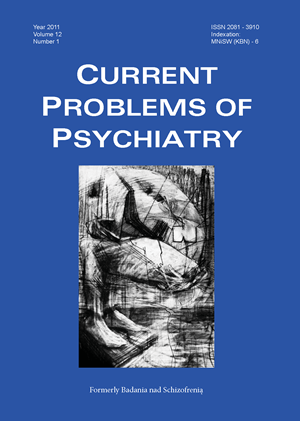Niepożądane działania kardiologiczne leków przeciwpsychotycznych - doniesienia wstępne
Słowa kluczowe:
leki II generacji, EKG, odstęp QTcAbstrakt
Wstęp: Stosowanie leków przeciwpsychotycznych wiąże się z działaniami niepożądanymi z zakresu układu sercowonaczyniowego. Wynika to z wieloreceptorowego działania leków przeciwpsychotycznych głównie poprzez receptory adrenergiczne, histaminowe, muskarynowe oraz serotoninowe. Istotnym powikłaniem są zaburzenia rytmu serca. Czynnikiem ryzyka powodującym zwiększenie prawdopodobieństwa wystąpienia zaburzeń rytmu jest polekowe wydłużenie odstępu QT.
Cel: Celem pracy jest określenie wpływu stosowanych leków przeciwpsychotycznych na czas trwania QTc oraz stwierdzenie czy pojawiły się jakieś zaburzenia rytmu w zapisie EKG podczas stosowania atypowych leków przeciwpsychotycznych. Metody: W badaniu wzięło udział 51 osób hospitalizowanych w Klinice Psychiatrii Dorosłych UM w Łodzi. Pacjenci leczeni byli olanzapiną (n= 20), arypiprazolem (n=16) oraz zyprasidonem (n=15). Każdemu pacjentowi wykonano dwukrotnie 12 odprowadzeniowe badanie EKG przed przyjęciem stosowanego leku oraz w trakcie jego przyjmowania.EKG oceniano pod kątem występujących zaburzeń rytmu oraz mierzono manualnie wzorem Bazzeta czas trwania QTc i jego zmianę.
Wyniki: Wśród badanych pacjentów nie zaobserwowano polekowych zaburzeń rytmu. Nie zaobserwowano wydłużenia QTc powyżej 450 ms u mężczyzn oraz powyżej 470ms u kobiet na żadnym stosowanym leku przeciwpsychotycznym. Poziom potasu u wszystkich pacjentów mieścił się w granicach normy. U żadnego pacjenta nie występowała bradykardia (HR poniżej 50/min) oraz tachykardia (HR > 100/min).
Wnioski: Atypowe leki przeciwpsychotyczne takie jak olanzapina, arypiprazol, zyprasidon można uznać za bezpieczne kardiologicznie. Nie powodują one groźnych dla życia zaburzeń rytmu ani istotnego statystycznie wydłużenia czasu trwania QTc.
Bibliografia
1. Mackin P. Cardiac side effects of psychiatric drug in human psychopharmacology: Clinical and Experimental, 2008; 23: 3-14.
2. Hedley P.L., Jorgensen P., Schlamowitz S., Wangari R., Moolman – Smook J., Brink P.A., Kanters J.K., Corfield V.A., Chrostiansen M. The genetic basis of long QT and short QT syndromes: a mutation update. Hum. Mutat., 2009; 30(11): 1486-1511.
3. Haddad P.M., Anderson I.M. Antipsychotic-related QTc prolongation, torsade de pointes and sudden death. Drugs, 2002; 62:1649-1671.
4. Gupta A., Lawrence A.T., Krishan K., Kavinsky C.J., Trohman R.G. Current concepts in the mechanisms and management of drug-induced QT prolongation and torsade de pointes. Am. Heart. J., 2007; 153: 891-899.
5. Bazzet H.C. An analysis of the time relations of electrocardiogram. Heart, 1920; 7: 353.
6. Hodges M., Salerno D., Erlien D. Bazett’s QT correlation reviewed. Evidence that a linear QT correction for heart is better. J. Amer. Coll. Cardiol., 1983; 1: 694.
7. Bednar M.M., Harrigan E.P., Anziano R.J., Camm A.J., Ruskin J.N. The QT interwal. Prog Cardiovasc Dis, 2001; 43(5 Suppl 1): 1-45.
8. Strachan E.M., Kelley C.A., Bateman D.M. Electrocardiogram and cardiovascular changes in thioridazine and chlorpromazine poisoning. Eur. J. Clin. Pharmacol., 2004; 60: 541-545.
9. Choi S.Y., Koh Y.S., Jo S.H. Inhibition of human ether-a-go-gorelated gene K+ channel and IKr of guinea pig cardiomyocytes by antipsychotic drug trifluoperazine. J. Pharmacol. Exp. Ther., 2005; 313: 888-895.
10. Glassman A.H., Bigger J.T. Jr. Antipsychotic drugs: prolonged QTc interval, torsade de pointes, and sudden death. Am. J. Psychiatry, 2001; 158: 1774-1782.
11. Yap Y.G., Camm A.J. Drug induced QT prolongation and torsad es de pointes. Heart, 2003; 89: 1363-1372.
12. Reilly J.G., Ayis S.A., Ferrier I.N., Jones S.J., Thomas S.H. QTcinterval abnormalities and psychotropic drug therapy in psychiatric patients. Lancet, 2000; 355(9209):1048-1052.
13. Czekalla J., Beasley C.M. Jr, Dellva M.A., Berg P.H., Grundy S. Analysis of the QTc interval during olanzapine treatment of patients with schizophrenia and related psychosis. J. Clin. Psychiatry, 2001; 62: 191-198.
14. Kane J.M., Carson W.H., Saha A.R., McQuade R.D., Ingenito G.G., Zimbroff D.L., Ali M.W. Efficacy and safety of aripiprazole and haloperidol versus placebo in patients with schizophrenia and schizoaffective disorder. J. Clin. Psychiatry, 2002; 63(9): 763-771.
15. Marder S.R., McQuade R.D., Stock E., Kaplita S., Marcus R., Safferman A.Z., Saha A., Ali M., Iwamoto T. Aripiprazole in the treatment of schizophrenia: safety and tolerability in short-term, placebo- controlled trials. Schizophr. Res., 2003; 61(2-3):123-136.
16. Kelly D.L., Love R.C. Ziprasidone and the QTc interval: pharmacokinetic and pharmacodynamic considerations. Psychopharmacol. Bull., 2001; 35: 66.79.
17. Biswas A.K., Zabrocki L.A., Mayes K.L., Morris-Kukoski C.L. Cardiotoxicity associated with intentional ziprasidone and bupropion overdose. J. Toxicol. Clin. Toxicol., 2003; 41: 79-82.
18. Miceli J.J., Anziano M.S., Swift R.H., et al. IM ziprasidone and IM haloperidol show comparable QTc effects at Cmax. Poster presented at: 156th Annual Meeting of the American Psychiatric Assciation; May 17-22, 2003; San Francisco, CA.
19. Miceli J.J., Murray S., Sallee F.R., Tensfeldt T.G., Versavel M. Phamacokinetic and pharmacodynamic QTc profile of oral ziprasidone in pediatric and adult subjects following single-dose administration. Poster presented at: 157th Annual Meeting of the American Psychiatric Association; May 1-6, 2004; New York, NY.
Pobrania
Opublikowane
Numer
Dział
Licencja
Prawa autorskie (c) 2011 Autorzy

Praca jest udostępniana na licencji Creative Commons Attribution-NonCommercial-NoDerivatives 3.0 Unported License.


